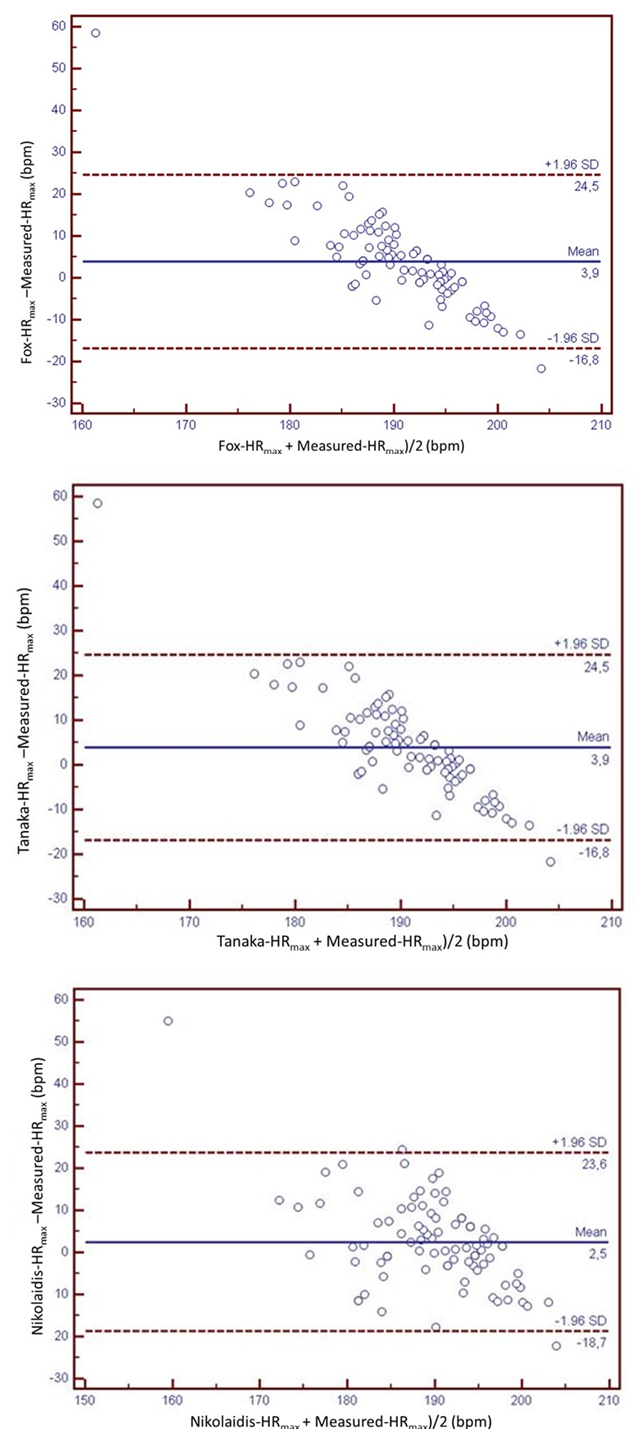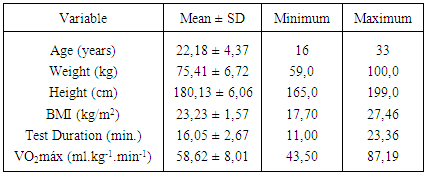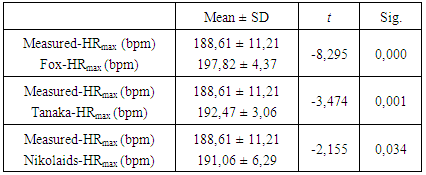-
Paper Information
- Previous Paper
- Paper Submission
-
Journal Information
- About This Journal
- Editorial Board
- Current Issue
- Archive
- Author Guidelines
- Contact Us
International Journal of Sports Science
p-ISSN: 2169-8759 e-ISSN: 2169-8791
2016; 6(6): 215-218
doi:10.5923/j.sports.20160606.03

Comparison between Age-Predicted and Measured Maximal Heart Rate in Professional Soccer Athletes
Daniel Carlos Garlipp1, Osvaldo Donizete Siqueira1, Luiz Antonio Barcellos Crescente1, Diogo Bezzi Jaeger1, Tiago Luiz Luz Leiria2
1Laboratório de Fisiologia e Medicina do Exercício, Universidade Luterana do Brasil, Canoas/RS, Brazil
2Serviço de Eletrofisiologia, Instituto de Cardiologia, Porto Alegre/RS, Brazil
Correspondence to: Daniel Carlos Garlipp, Laboratório de Fisiologia e Medicina do Exercício, Universidade Luterana do Brasil, Canoas/RS, Brazil.
| Email: |  |
Copyright © 2016 Scientific & Academic Publishing. All Rights Reserved.
This work is licensed under the Creative Commons Attribution International License (CC BY).
http://creativecommons.org/licenses/by/4.0/

The aim of this study was to compare the measure maximal heart rate (measure-HRmax) available in maximum treadmill test with age-predicted-HRmax from the Karvonen (Fox-HRmax), Tanaka (Tanaka- HRmax) and Nikolaidis (Nikolaids-HRmax) methods. Ninety players, aged 16 and 33 years, a first division club of Brazilian football participate in this study. A Bruce protocol was used in the treadmill to assess the maximal aerobic running speed. Measured-HRmax was defined as the highest value attained during the test. Data were expressed as mean, standard deviation (SD) of the mean, minimum and maximal values. Independent Student’s t‑test, Bland-Altman analysis and Pearson’s correlation coefficient was using in statistical analyses. Our results showed that none of the three available equations (Fox, Tanaka and Nikolaids) provides accurate values of HRmax in a sample of professional soccer players. The three equations overestimated measure-HRmax. However, the equation that provided the most accurate measured-HRmax was the Nikolaids equation. This is true probably to the fact that this equation has been developed from a sample soccer player.
Keywords: Soccer, Heart Rate, Athlets
Cite this paper: Daniel Carlos Garlipp, Osvaldo Donizete Siqueira, Luiz Antonio Barcellos Crescente, Diogo Bezzi Jaeger, Tiago Luiz Luz Leiria, Comparison between Age-Predicted and Measured Maximal Heart Rate in Professional Soccer Athletes, International Journal of Sports Science, Vol. 6 No. 6, 2016, pp. 215-218. doi: 10.5923/j.sports.20160606.03.
1. Introduction
- The heart rate (HR) is a non-invasive marker often used for prescribing exercise and training [1]. Variability and application in sport has been extensively studied in recent years [2-4]. Although the HR is a seemingly simple data to be gathered during exercise it can be evaluated according to several methods and measurement at different times during the effort. The HR measurement can generate a large number of indexes, each with its pros and against, which should be considered in the monitoring of different sports and athletes.According Nikolaidis [5], the age-predicted maximal heart rate (age-predicted-HRmax) is the most commonly used by coaches and trainers. In soccer we usually use this method of estimation of HRmax even in different intensities of training.Bangsbo et al [6] states that the average HR of a football player is rarely less than 65% of HRmax, and can reach peaks of around 98%. However, the intensity average value measured as a percentage of HRmax is approximately 85%. In this sense, the optimization of the training should take into consideration the workload in order to optimize the adjustments to improve the performance [7]. Buchheit [1] reported that to quantify the amount of training the integration of external stress indicators with internal indicators are required. These data should be recorded along the training session in order to obtain composite measurements of training load.Several equations have been proposed in order to age-predicted-HRmax, because the maximal exercise test is not always feasible [8]. These equations leave the physiological assumption that the HRmax tends to decrease with aging, possibly due to a lower activity autonomic nervous system [9]. In addition to the equation 220 - age [10], another widely used equation is the 208 - 0,7 x age [6]. The latter has showed to provide a greater accuracy in age-predicted-HRmax, based on the results of a meta-analysis combined with a cross-validation study. More recently Nikolaidis [11] proposed the equation 223 - 1,44 x age after evaluating 162 adolescents (age = 15.8 ± 1.5 years) and 158 adults (age = 23.4 ± 4.6 years) all football players tied to competitive clubs.Therefore, the aim of this study was to compare the measure maximal heart rate (measure-HRmax) available in maximum treadmill test with age-predicted-HRmax from the Karvonen (Fox-HRmax), Tanaka (Tanaka- HRmax) and Nikolaidis (Nikolaids-HRmax) methods.
2. Material and Methods
- Ninety players, aged 16 and 33 years, a first division club of Brazilian football participate in this study. Weight (kg) and height (cm) were measured with subjects in minimal clothing and barefoot. Body mass index was calculated as the quotient of body mass (kg) to height squared (m2).A Bruce protocol was used in the treadmill to assess the maximal aerobic running speed as previously described [12]. The treadmill used was a multiprogram treadmill by Inbramed, model KT 10200 ATL. Measured-HRmax was defined as the highest value attained during the test. HR was recorded continuously during the test by Team2 Pro (Polar Electro Oy, Kempele, Finland).Statistical analyses were performed using IBM SPSS v. 20.0. Data were expressed as mean, standard deviation (SD) of the mean, minimum and maximal values. Independent Student’s t‑test was used to examine the differences between measure-HRmax and age-predicted-HRmax from the Fox-HRmax, Tanaka- HRmax and Nikolaidis-HRmax methods. Bland-Altman analysis was used to examine the accuracy and variability of prediction equations. Associations between measured HRmax and age were determined using Pearson’s product moment correlation coefficient (r). Magnitude of correlation coefficients was considered as trivial if r ≤ 0.1, small if 0.1 ≤ r < 0.3, moderate if 0.3 ≤ r < 0.5, large if 0.5 ≤ r < 0.7, very large if 0.7 ≤ r < 0.9, nearly perfect if r ≥ 0.9, and perfect if r = 1. The level of significance was set at α =0.05.Our local ethical research committee approved the protocol for the study and it is in agreement with the Helsinks’declaration (CAAE: 57112616.2.0000.5349).
3. Results
- The basic characteristics of the participants are presented in Table 1. The measured-HRmax and age-predicted-HRmax correlation values are described in Table 2 and comparisons between the measured-HRmax and age-predicted-HRmax are in Table 3.
|
|
|
 | Figure 1. Bland-Alman plots of the difference between Fox-HRmax (A), Tanaka-HRmax (B) and Nikolaidis-HRmax (C) and Measured-HRmax |
4. Discussion
- HRmax at a given age is frequently estimated by the 220 - age formula. This is usually implemented in nearly all commercial equipment for cardiac stress testing. However, the validity of this formula has often been questioned [8, 13]. According Tibana et al [14], the formula 220 - age has a tendency to overestimate HRmax in young subjects and underestimate her in the elderly. However, according Caputo et al [15], the proposed equation by Tanaka et al [8] overestimate the HRmax whit respect to the measured end of a maximal exercise test.Several studies have been produced with different populations. From a sample of 11 physical educations students, aged 18 and 26 years, Vasconcelos [16] identified HRmax responses similar to using the Fox equation but not from the equation proposed by Imbar et al [17]. Cleary et al [18] when evaluating the HRmax of 96 students healthy volunteers, and compared with 7 age-predicted-HRmax equations concluded that the Gellish2 and Fairbarn equations were the most accurate of the age-predicted-HRmax equations in a college-age population.Petto et al [19], compared age-predicted-HRmax against the one obtained in the 220 - age formula showing that it overestimates measured-HRmax when using the maximal aerobic test whit Bruce protocol. When evaluating 35 indoor soccer athletes of booth sex, Souza et al [20], did not find significant correlations between measured-HRmax and Fox-HRmax, Tanaka-HRmax and Nikolaids-HRmax. With 23 individuals, handball practitioners, age 12 and 14, Tibana et al [14] identified significantly smaller measured-HRmax values than those age-predicted-HRmax from the Tanaka-HRmax and HRmax predicted by the American College of Sports Medicine equation.Examining the relationship between HRmax and age in 3320 healthy men and women within a wide age range using data from the HUNT Fitness Study (2007–2008), Nes et al [21], the Fox-HRmax, Tanaka-HRmax and the female-based equation by Gulati-HRmax underestimated measured-HRmax in the present population. Camarda et al [22], to evaluate 1091 results of HRmax of sedentary males and 956 females reported that the Karvonen and Tanaka's equations are similar to the HRmax prediction and show good correlation with measured-HRmax.However, few studies have been directed to soccer players. A sample of 162 adolescents (15,8±1,5 years) and 158 adults’ (23,4±4,6 years) players, Nikolaidis [11] identified in the total sample, Fox‑HRmax overestimated measured‑HRmax, while Tanaka‑HRmax underestimated HRmax. In adolescents, Fox‑HRmax overestimated measured‑HRmax and Tanaka‑HRmax underestimated HRmax. In adults, Tanaka‑HRmax underestimated HRmax, while there was not any difference between Fox‑HRmax and measured‑HRmax. Nikolaidis [23] in another study, when evaluating young soccer players together with athletes from other sports (futsal, basketball and water polo), all members of competitive clubs, identified Fox-HRmax and Nikolaidis-HRmax overestimated measured-HRmax, while Tanaka-HRmax underestimated. The results of this study differ somewhat from the studies cited, given that the Fox-HRmax [9,21 bpm (-16; 63)], Tanaka-HRmax [3,86 bpm (-21,70; 58,50)] and Nikolaidis-HRmax [2,45 bpm (-22,24; 55)] equation overestimated the HR values when compared to the measured-HRmax. The important practical implications are to recognize the risks that coaches and fitness trainers undertake depending on which their choice of prediction equation is. Using Fox, Tanaka or Nikolaidis equation, which tend to overestimate HR, might result in prescribing high exercise intensity.According Sarzynski [24], a true maximal exercise test is the gold standard measure of maximal aerobic power compared with symptom-limited and submaximal/predictive tests. According Spina et al [25], a decrease in HRmax as a direct result of training. However, a decrease in HRmax as a result of training is inconsistent among athletes [26]. This seems to be an relevant issue with important practical implications because we need to recognize the risks that coaches and fitness trainers undertake depending on which is their choice of maximal HR prediction equation is.The main limitation of this study is the wide range of ages in on sample is due to the fact that Brazilian Football Confederation (CBF) in its National Regulation of Registration and Transfer of Athletes [27] recognizes as a professional player those with a minimum age of 16 and this happened in one of our athletes. This range may preclude the full accuracy for the use of these formulas to predict what is supposed to be the estimated target HR for our sample. Also the size of your population may limit the strength of our rusts.
5. Conclusions
- Our results showed that none of the three available equations (Fox, Tanaka and Nikolaids) provides accurate values of HRmax in a sample of professional soccer players. The three equations overestimated measure-HRmax. However, the equation that provided the most accurate measured-HRmax was the Nikolaids equation. This is true probably to the fact that this equation has been developed from a sample soccer player.
 Abstract
Abstract Reference
Reference Full-Text PDF
Full-Text PDF Full-text HTML
Full-text HTML

